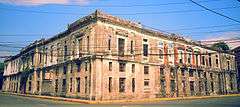Aduana Building
| Aduana Building | |
|---|---|
| La Intendencia | |
 The Aduana Building, also known as the Intendencia | |
| Alternative names | Custom House |
| General information | |
| Type | Government building |
| Architectural style | Neoclassical |
| Address | Soriano Ave. corner Muralla St. |
| Town or city | Intramuros, Manila |
| Country | Philippines |
| Coordinates | 14°35′38″N 120°58′28″E / 14.5939°N 120.9745°ECoordinates: 14°35′38″N 120°58′28″E / 14.5939°N 120.9745°E |
| Owner | National Archives of the Philippines |
| Technical details | |
| Material | Adobe stones |
| Design and construction | |
| Architect | Tomas Cortes |
The Aduana Building, also known as the Intendencia, was a Spanish colonial structure in Manila, Philippines that housed several government offices through the years. It is located in front of the BPI Intramuros (formerly the site of the old Santo Domingo Church) at Plaza España, Soriano (Aduana) Ave. corner Muralla St. in Intramuros.
Architecture
This two-storey governmental structure follows a Neo-Classical tradition, with an emphasized horizontality and symmetrical form, particularly on the design of its façade.[1] The central bay had three arched entrances and two principal staircases built around the two atriums.[2] The rectangular fenestration on the upper most story were decorated with rustication. The window-like portals opening out to small balconies were framed with pilasters topped with ornate capitals and were adorned with elaborate geometrical grillework. Similar ornate grillework also decorated the main entryways in the building.[1]
History
The Aduana, or Custom House, was built in Intramuros to attract merchants to remain within its walls rather than outside of it.[2] Records show that in 1822, a Spanish engineer Tomás Cortes took charge of the project and began its construction in 1823. Despite objections due to insufficient space for warehousing and its distance from the port, the construction continued until its completion in 1829.[2] However, in 1863 the Aduana suffered damages from an earthquake, which led to its demolition in 1872.[3] Reconstruction of the building was later awarded to Luis Perez Yap-Sionjue, which began in 1874 and was completed in 1876. The rebuilding of the structure was still based from the original design of Cortes[1] but it has now housed the Custom Offices, the Civil Administration Office (Intendencia General de Hacienda), the Treasury, and the Mint House (Casa de Moneda).[2][3] When the Customs transferred, the offices of the Mint House and Treasury remained in the building and was renamed as Intendencia.[1]
During World War II, the building once again suffered damages; first by the Japanese bombings in 1941 and later on by the American and Filipino military artillery during the Battle of Manila of 1945.[3] It was repaired after the war and functioned as the Offices of the Central Bank of the Philippines, the National Treasury and eventually the Commission on Elections.[2] Its eventual abandonment was in 1979 when the building was ravaged by fire.[2][3][1]
In 1997, the National Archives acquired the building to serve as their future office. Restoration efforts have already commenced as to date.[4][5]
References
- 1 2 3 4 5 "The Aduana Intendencia". Retrospektura. Accessed on 03 May 2014.
- 1 2 3 4 5 6 "Aduana". Intramuros. Retrieved 1 January 2015.
- 1 2 3 4 Torres, Jose Victor Z. 2005. Ciudad Murada: A Walk Through Historic Intramuros. Manila: Intramuros Administration and Vibal Publishing House. ISBN 971072276X
- ↑ Ignacio, Teresita. "National Archives of the Philippines". National Commission for Culture and the Arts. Archived from the original on 1 January 2015. Retrieved 1 January 2015.
- ↑ Villaon, Augusto. "What being 'endangered' means for Intramuros". Philippine Daily Inquirer. Retrieved 1 January 2015.
External links
![]() Media related to Aduana, Intramuros at Wikimedia Commons
Media related to Aduana, Intramuros at Wikimedia Commons